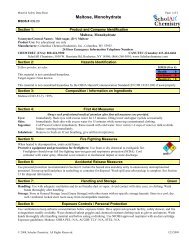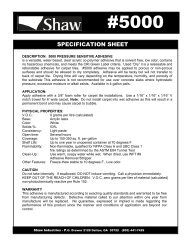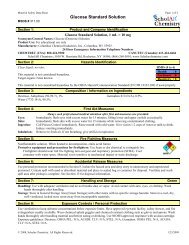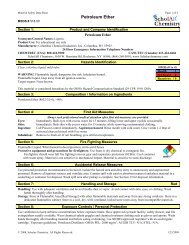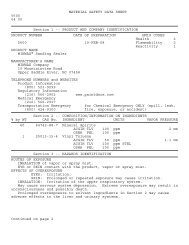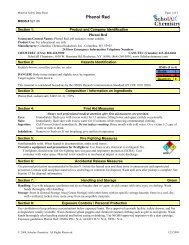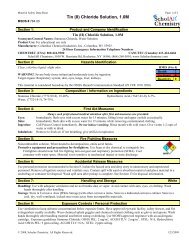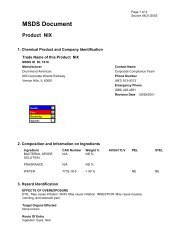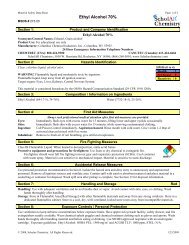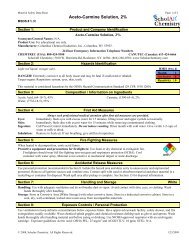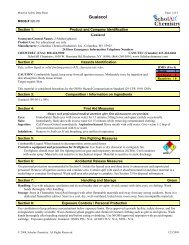Kendall SHP Grease 2.pdf
Kendall SHP Grease 2.pdf
Kendall SHP Grease 2.pdf
You also want an ePaper? Increase the reach of your titles
YUMPU automatically turns print PDFs into web optimized ePapers that Google loves.
<strong>Kendall</strong> <strong>SHP</strong> <strong>Grease</strong> 2<br />
(MSDS #7894020000)<br />
Page 1 of 6<br />
MATERIAL SAFETY DATA SHEET<br />
<strong>Kendall</strong> <strong>SHP</strong> <strong>Grease</strong> 2<br />
1. PRODUCT AND COMPANY IDENTIFICATION<br />
Product Name: <strong>Kendall</strong> <strong>SHP</strong> <strong>Grease</strong> 2<br />
Product Code: 7894020000<br />
Sap Code:<br />
Intended Use: <strong>Grease</strong><br />
Chemical Family: Petroleum hydrocarbon<br />
Responsible Party: Phillips 66 Company<br />
Lubricants Division<br />
P.O. Box 25376<br />
Santa Ana, CA 92799-5376<br />
For Additional MSDSs: 800-762-0942<br />
Technical Information:<br />
The intended use of this product is indicated above. If any additional use is known, please contact us at the<br />
Technical Information number listed.<br />
24 Hour Emergency Telephone Numbers:<br />
Spill, Leak, Fire or Accident<br />
Call CHEMTREC<br />
North America: (800)424-9300<br />
Others: (703)527-3887 (collect)<br />
EMERGENCY OVERVIEW<br />
California Poison Control System: (800) 356-3129<br />
Health Hazards/Precautionary Measures: Avoid contact with eyes, skin and clothing. Wash thoroughly after<br />
handling.<br />
Physical Hazards/Precautionary Measures: Keep away from all sources of ignition.<br />
Appearance:<br />
Physical Form:<br />
Odor:<br />
Red<br />
Semi-solid<br />
Mild bland petroleum<br />
NFPA Hazard Class:<br />
HMIS Hazard Class<br />
Health: 1 (Slight) Not Evaluated<br />
Flammability: 1 (Slight)<br />
Reactivity: 0 (Least)<br />
2. COMPOSITION/INFORMATION ON INGREDIENTS<br />
No hazardous components identified per 29 CFR 1910.1200.<br />
___________________________________________________________________________________________<br />
OTHER COMPONENTS<br />
% WEIGHT EXPOSURE GUIDELINE<br />
Limits Agency Type<br />
Lubricant Base Oil (Petroleum) 70-80 (See: Oil Mist, If Generated)<br />
CAS# Various
<strong>Kendall</strong> <strong>SHP</strong> <strong>Grease</strong> 2 (MSDS #7894020000)<br />
Page 2 of 6<br />
Additives 20-30 Not Established<br />
CAS# Proprietary<br />
____________________________________________________________________________________________<br />
REFERENCE<br />
3. HAZARDS IDENTIFICATION<br />
EXPOSURE GUIDELINE<br />
Limits Agency Type<br />
Oil Mist, If Generated 5 mg/m3 ACGIH TWA<br />
CAS# None<br />
10 mg/m3 ACGIH STEL<br />
5 mg/m3 OSHA TWA<br />
2500 mg/m3 NIOSH IDLH<br />
All components are listed on the TSCA inventory<br />
The base oil for this product can be a mixture of any of the following highly refined petroleum streams:<br />
CAS 64741-88-4; CAS 64741-89-5; CAS 64741-96-4; CAS 64741-97-5; CAS 64742-01-4; CAS 64742-52-5; CAS<br />
64742-53-6; CAS 64742-54-7; CAS 64742-55-8; CAS 64742-56-9; CAS 64742-57-0; CAS 64742-62-7; CAS<br />
64742-63-8; CAS 64742-65-0; CAS 72623-85-9; CAS 72623-86-0; CAS 72623-87-1<br />
Note: State, local or other agencies or advisory groups may have established more stringent limits.<br />
Consult an industrial hygienist or similar professional, or your local agencies, for further information.<br />
Potential Health Effects:<br />
Eye: Contact may cause mild eye irritation including stinging, watering, and redness.<br />
Skin: Contact may cause mild skin irritation including redness, and a burning sensation. Prolonged or repeated<br />
contact can worsen irritation by causing drying and cracking of the skin leading to dermatitis (inflammation).<br />
No harmful effects from skin absorption are expected.<br />
Inhalation (Breathing): No data available. However, inhalation is not an expected route of<br />
exposure.<br />
Ingestion (Swallowing): No harmful effects expected from ingestion.<br />
Signs and Symptoms: Effects of overexposure may include irritation of the nose and throat,<br />
irritation of the digestive tract, nausea and diarrhea.<br />
Cancer: Inadequate evidence available to evaluate the cancer hazard of this material. See Section 11 for<br />
carcinogenicity information of individual components, if any.<br />
Target Organs: No data available for this material.<br />
Developmental: No data available for this material.<br />
Pre-Existing Medical Conditions:<br />
disorders.<br />
Conditions aggravated by exposure may include skin<br />
4. FIRST AID MEASURES<br />
Eye:<br />
If irritation or redness develops, move victim away from exposure and into fresh air. Flush eyes<br />
with clean water. If symptoms persist, seek medical attention.
<strong>Kendall</strong> <strong>SHP</strong> <strong>Grease</strong> 2 (MSDS #7894020000)<br />
Page 3 of 6<br />
Skin: Wipe material from skin and remove contaminated shoes and clothing. Cleanse affected area(s)<br />
thoroughly by washing with mild soap and water and, if necessary, a waterless skin cleanser. If<br />
irritation or redness develops and persists, seek medical attention.<br />
Inhalation (Breathing): If respiratory symptoms develop, move victim away from source of exposure and into<br />
fresh air. If symptoms persist, seek medical attention. If victim is not breathing, clear airway and immediately<br />
begin artificial respiration. If breathing difficulties develop, oxygen should be administered by qualified<br />
personnel. Seek immediate medical attention.<br />
Ingestion (Swallowing): First aid is not normally required; however, if swallowed and symptoms develop, seek<br />
medical attention.<br />
Note To Physicians: High-pressure hydrocarbon injection injuries may produce substantial<br />
necrosis of underlying tissue despite an innocuous appearing external wound. Often these injuries<br />
require extensive emergency surgical debridement and all injuries should be evaluated by a<br />
specialist in order to assess the extent of injury.<br />
5. FIRE FIGHTING MEASURES<br />
Flammable Properties:<br />
Unusual Fire & Explosion Hazards:<br />
Fire Fighting Instructions: For fires beyond the incipient stage, emergency responders in the immediate hazard<br />
area should wear bunker gear. When the potential chemical hazard is unknown, in enclosed or confined spaces, or<br />
when explicitly required by DOT, a self contained breathing apparatus should be worn. In addition, wear other<br />
appropriate protective equipment as conditions warrant (see Section 8).<br />
Isolate immediate hazard area, keep unauthorized personnel out. Contain spill if it can be done with minimal risk.<br />
Move undamaged containers from immediate hazard area if it can be done with minimal risk.<br />
Cool equipment exposed to fire with water, if it can be done with minimal risk.<br />
6. ACCIDENTAL RELEASE MEASURES<br />
This material may burn, but will not ignite readily. Keep all sources of ignition away from spill/release. Stay<br />
upwind and away from spill. Notify persons down wind of the spill/release, isolate immediate hazard area and keep<br />
unauthorized personnel out. Contain spill if it can be done with minimal risk. Wear appropriate protective<br />
equipment including respiratory protection as conditions warrant (see Section 8).<br />
Prevent spilled material from entering sewers, storm drains, other unauthorized drainage systems, and natural<br />
waterways. Notify fire authorities and appropriate federal, state, and local agencies. Cleanup under expert<br />
supervision is advised. Minimize dust generation. Sweep up and package appropriately for disposal. If spill of<br />
any amount is made into or upon navigable waters, the contiguous zone, or adjoining shorelines, notify the National<br />
Response Center (phone number 800-424-8802).<br />
7. HANDLING AND STORAGE<br />
Flash Point: >400°F/>204°C (COC)<br />
OSHA Flammability Class: Not regulated<br />
LEL/UEL%: No Data<br />
Autoignition Temperature: No Data<br />
Burn Rate (solids): No Data<br />
This material may burn, but will not ignite readily.<br />
Extinguishing Media: Dry chemical, carbon dioxide, foam, water, sand, or earth is recommended. Carbon dioxide<br />
can displace oxygen. Use caution when applying carbon dioxide in confines spaces.<br />
Handling: The use of appropriate respiratory protection is advised when concentrations exceed any<br />
established exposure limits (see Sections 2 and 8).
<strong>Kendall</strong> <strong>SHP</strong> <strong>Grease</strong> 2<br />
(MSDS #7894020000) Page 4 of 6<br />
Do not wear contaminated clothing or shoes. Use good personal hygiene practices.<br />
High pressure injection of hydrocarbon fuels, hydraulic oils or greases under the skin may have serious<br />
consequences even though no symptoms or injury may be apparent. This can happen accidentally when using<br />
high pressure equipment such as high pressure grease guns, fuel injection apparatus or from pinhole leaks in<br />
tubing of high pressure hydraulic oil equipment.<br />
"Empty" containers retain residue and may be dangerous. Do not pressurize, cut, weld, braze, solder, drill,<br />
grind, or expose such containers to heat, flame, sparks, or other sources of ignition. They may explode and<br />
cause injury or death. "Empty" drums should be completely drained, properly bunged, and promptly shipped to<br />
the supplier or a drum reconditioner. All containers should be disposed of in an environmentally safe<br />
manner and in accordance with governmental regulations.<br />
Before working on or in tanks which contain or have contained this material, refer to OSHA regulations, ANSI<br />
Z49.1 and other references pertaining to cleaning, repairing, welding, or other contemplated operations.<br />
Storage: Keep container(s) tightly closed. Use and store this material in cool, dry, well-ventilated<br />
areas away from heat and all sources of ignition. Store only in approved containers. Keep away from any<br />
incompatible material (see Section 10). Protect container(s) against physical damage.<br />
8. EXPOSURE CONTROLS/PERSONAL PROTECTION<br />
Engineering controls: If current ventilation practices are not adequate to maintain airborne concentrations below<br />
the established exposure limits (see Section 2), additional ventilation or exhaust systems may be required.<br />
Personal Protective Equipment (PPE):<br />
Respiratory: Inhalation is not an expected route of exposure. However, a NIOSH certified<br />
air purifying respirator with a Type 95 (R or P) particulate filter may be used under<br />
conditions where airborne concentrations are expected to exceed exposure limits (see<br />
Section 2).<br />
Protection provided by air purifying respirators is limited (see manufacturer's respirator<br />
selection guide). Use a positive pressure air supplied respirator if there is potential<br />
for uncontrolled release, exposure levels are not known, or any other circumstances where<br />
air purifying respirators may not provide adequate protection.<br />
A respiratory protection program that meets OSHA's 29 CFR 1910.134 and ANSI Z88.2<br />
requirements must be followed whenever workplace conditions warrant a respirator's use.<br />
Skin:<br />
The use of gloves impervious to the specific material handled is advised to prevent skin<br />
contact and possible irritation (see manufacturers literature for information on<br />
permeability).<br />
Eye/Face: Approved eye protection to safeguard against potential eye contact, irritation, or<br />
injury is recommended. Depending on conditions of use, a face shield may be necessary.<br />
Other Protective Equipment: A source of clean water should be available in the work<br />
area for flushing eyes and skin. Impervious clothing should be worn as needed.<br />
9. PHYSICAL AND CHEMICAL PROPERTIES<br />
Note: Unless otherwise stated, values are determined at 20°C (68°F) and 760 mm Hg (1 atm).<br />
Burn Rate (solids only): No Data<br />
Appearance: Red<br />
Physical State: Semi-solid<br />
Odor: Mild bland petroleum<br />
Vapor Pressure (mm Hg):
<strong>Kendall</strong> <strong>SHP</strong> <strong>Grease</strong> 2<br />
(MSDS #7894020000)<br />
Vapor Density (air=1): >1<br />
Boiling Point/Range: >500°F / >260°C<br />
Freezing/Melting Point: No Data<br />
Solubility in Water: Negligible<br />
Specific Gravity: 0.96<br />
Percent Volatile: Negligible<br />
Evaporation Rate (nBuAc=1): 400°F / >204°C (COC)<br />
Flammable/Explosive Limits (%): No Data<br />
Page 5 of 6<br />
10. STABILITY AND REACTIVITY<br />
Stability: Stable under normal ambient and anticipated storage and handling conditions of temperature and<br />
pressure.<br />
Conditions To Avoid:<br />
Extended exposure to high temperatures can cause decomposition.<br />
Materials to Avoid (Incompatible Materials): Avoid contact with strong oxidants such as liquid chlorine,<br />
concentrated oxygen, sodium hypochlorite, calcium hypochlorite, etc.<br />
Hazardous Decomposition Products: Combustion can yield carbon, nitrogen, sulfur and phosphorus oxides.<br />
Hazardous Polymerization:<br />
Will not occur.<br />
11. TOXICOLOGICAL INFORMATION<br />
Lubricant Base Oil (Petroleum) (CAS# Various)<br />
Carcinogenicity: The petroleum base oils contained in this product have been highly refined by a<br />
variety of processes including solvent extraction, hydrotreating, and dewaxing to remove aromatics and<br />
improve performance characteristics. None of the oils used are listed as a carcinogen by NTP, IARC, or<br />
OSHA.<br />
12. ECOLOGICAL INFORMATION<br />
Not evaluated at this time<br />
13. DISPOSAL CONSIDERATIONS<br />
This material, if discarded as produced, is not a RCRA "listed" or "characteristic" hazardous waste. Use which<br />
results in chemical or physical change or contamination may subject it to regulation as a hazardous waste. Along<br />
with properly characterizing all waste materials, consult state and local regulations regarding the proper disposal<br />
of this material.<br />
14. TRANSPORT INFORMATION<br />
Note: Not classified as hazardous<br />
15. REGULATORY INFORMATION<br />
EPA SARA 311/312 (Title III Hazard Categories):
<strong>Kendall</strong> <strong>SHP</strong> <strong>Grease</strong> 2<br />
(MSDS #7894020000)<br />
Page 6 of 6<br />
Acute Health: No<br />
Chronic Health: No<br />
Fire Hazard: No<br />
Pressure Hazard: No<br />
Reactive Hazard: No<br />
SARA 313 and 40 CFR 372:<br />
This material contains the following chemicals subject to the reporting requirements of SARA 313 and 40<br />
CFR 372:<br />
--None--<br />
California Proposition 65:<br />
Warning: This material contains the following chemicals which are known to the State of California to cause cancer,<br />
birth defects or other reproductive harm, and are subject to the requirements of California Proposition 65 (CA Health<br />
& Safety Code Section 25249.5):<br />
--None Known--<br />
Carcinogen Identification:<br />
This material has not been identified as a carcinogen by NTP, IARC, or OSHA. See Section 11 for<br />
carcinogenicity information of individual components, if any.<br />
EPA (CERCLA) Reportable Quantity:<br />
--None--<br />
16. OTHER INFORMATION<br />
Issue Date: 01/01/02<br />
Previous Issue Date: 04/01/01<br />
Product Code: 7894020000<br />
Revised Sections: None<br />
Previous Product Code: 7894000000<br />
MSDS Number: 7894020000<br />
Disclaimer of Expressed and Implied Warranties:<br />
The information presented in this Material Safety Data Sheet is based on data believed to be accurate as of the date this Material Safety Data<br />
Sheet was prepared. HOWEVER, NO WARRANTY OF MERCHANTABILITY, FITNESS FOR ANY PARTICULAR PURPOSE, OR ANY OTHER<br />
WARRANTY IS EXPRESSED OR IS TO BE IMPLIED REGARDING THE ACCURACY OR COMPLETENESS OF THE INFORMATION<br />
PROVIDED ABOVE, THE RESULTS TO BE OBTAINED FROM THE USE OF THIS INFORMATION OR THE PRODUCT, THE SAFETY OF<br />
THIS PRODUCT, OR THE HAZARDS RELATED TO ITS USE. No responsibility is assumed for any damage or injury resulting from abnormal<br />
use or from any failure to adhere to recommended practices. The information provided above, and the product, are furnished on the condition<br />
that the person receiving them shall make their own determination as to the suitability of the product for their particular purpose and on the<br />
condition that they assume the risk of their use. In addition, no authorization is given nor implied to practice any patented invention without a<br />
license.



